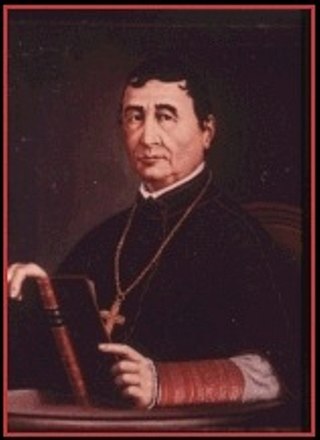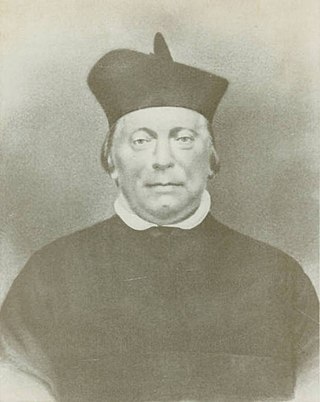
Grand Coteau is a town in St. Landry Parish, Louisiana, United States. The population was 947 at the 2010 census. Grand Coteau is on Interstate 49 south of Opelousas and is part of the Opelousas–Eunice Micropolitan Statistical Area. The town is a center for local farming. As of 2018, the mayor is Patrick Richard.

Loyola University New Orleans is a private Jesuit university in New Orleans, Louisiana. Originally established as Loyola College in 1904, the institution was chartered as a university in 1912. It bears the name of the Jesuit founder, Saint Ignatius of Loyola, and is a member of the Association of Jesuit Colleges and Universities.

Spring Hill College is a private Jesuit college in Mobile, Alabama. It was founded in 1830 by Michael Portier, Bishop of Mobile. Along with being the oldest college or university in the state of Alabama, it was the first Catholic college in the South, is the fifth-oldest Catholic college in the United States, and is the third-oldest member of the Association of Jesuit Colleges and Universities.

The Central Business District (CBD) is a neighborhood of the city of New Orleans, Louisiana, United States.

John Berchmans, SJ was a Jesuit scholastic and is revered as a saint in the Catholic Church.

Louis William Valentine DuBourg was a French Catholic prelate and Sulpician missionary to the United States. He built up the church in the vast new Louisiana Territory as the Bishop of Louisiana and the Two Floridas and later became the Bishop of Montauban and finally the Archbishop of Besançon in France.

Paul Octave Hébert was a soldier and politician who served as 14th Governor of Louisiana from 1853 to 1856. A veteran of the Mexican-American War, he later served as a brigadier general in the Confederate States Army.

Antoine Blanc was the fifth Bishop and first Archbishop of the Roman Catholic Archdiocese of New Orleans. His tenure, during which the diocese was elevated to an archdiocese, was at a time of growth in the city, which he matched with the most rapid church expansion in the history of New Orleans. More new parishes were established in New Orleans under his episcopacy than at any other time.

Schools of the Sacred Heart is a complex of two Catholic single-sex private schools for grades Pre-Kindergarten-3 through grade 12 in Grand Coteau, Louisiana.

Jean-Jacques-Alfred-Alexandre "Alfred" Mouton was a Confederate general in the American Civil War. Although trained at West Point, he soon resigned his commission to become a civil engineer and then a sugarcane grower, while also serving as a brigadier general in the Louisiana State Militia.

Loyola University New Orleans College of Law is a private law school in New Orleans, Louisiana affiliated with Loyola University New Orleans. Loyola's law school opened in 1914 and is now located on the Broadway Campus of the university in the historic Audubon Park District of the city. The College of Law is one of fourteen Jesuit law schools in the United States. It is also one of the few law schools in the nation to offer curricula in both Civil Law and Common Law. The school releases several academic journals, most notable of which is the Loyola Law Review.

Loyola College Prep is a private Catholic coeducational high school in Shreveport, Louisiana, founded by the Society of Jesus (Jesuits), but now operated by the Roman Catholic Diocese of Shreveport. It is among the oldest functioning former Jesuit high schools in the United States.

Robert Louis Mouton was a U.S. Representative from Louisiana.
Michael F. Kennelly, S.J., was an Irish-born American Jesuit and academic administrator. He was a member of the Society of Jesus for more than seventy-seven years.

Rose Philippine Duchesne, RCSJ, was a French religious sister and educator whom Pope John Paul II canonized in 1988. A native of France, she immigrated as a missionary to America, and is recognized for her care and education of Indigenous American survivors of the United States Indian removal programs.
George Francis Lundy, S.J., was an American Jesuit, academic, and university administrator. He served as the President of Wheeling Jesuit University in West Virginia from 2000 to 2003. Much of Lundy's work in activism and academia centered on issues concerning social justice.
Francesco (Francis) Cellini was a member of the Vincentian Order of priests connected to mission work serving the mid-western section of the United States during the mid-1800s. Cellini was born in the province of Ascoli Piceno, Marche Region, Italy. By 1818 he was the chaplain of the Hospital Santo Spirito in Rome in the Rione neighborhood near Vatican City. That same year he was accorded the habit of the Vincentian Order. After serving in Louisiana, Missouri, and Illinois, Cellini's ministerial work concluded with a posting in St. Louis, where he was made Vicar General of the St. Louis Diocese.

John Dunning Whitney was an American Catholic priest and Jesuit who became the president of Georgetown University in 1898. Born in Massachusetts, he joined the United States Navy at the age of sixteen, where he was introduced to Catholicism by way of a book that accidentally came into his possession and prompted him to become a Catholic. He entered the Society of Jesus and spent the next twenty-five years studying and teaching mathematics at Jesuit institutions around the world, including in Canada, England, Ireland, and around the United States in New York, Maryland, Boston, and Louisiana. He became the vice president of Spring Hill College in Alabama before being appointed the president of Georgetown University.

Peter Joseph Verhaegen was a Belgian Catholic priest, Jesuit, and missionary to the Midwestern United States who became the first president of Saint Louis University and St. Joseph's College in Bardstown, Kentucky.

















